Content
- 1 Raisins from raisins
- 2 Where did the bones go
- 3 Groups and varieties of seedless grapes
- 4 Classification of seedless grapes
- 5 "Arsenyevsky"
- 6 "Kesha"
- 7 "White Flame"
- 8 "Radiant"
- 9 "Black"
- 10 "Black Sultan"
- 11 "Red nutmeg"
- 12 "Black Cinnamon"
- 13 "Russian korinka"
- 14 Benefits of raisins grapes
- 15 How does reproduction take place
- 16 Most common seedless varieties
The Vinogradov family consists of 11 genera and over 600 species of natural grapes. Nevertheless, breeders do not stop breeding new cultivars and plant hybrids.
The demand for seedless grape varieties is constantly growing. It tastes better and is well suited for drying to obtain raisins. The cultivation of seedless varieties has ancient roots. After all, the first accounts of winemaking date back to the times of Odysseus. The cultivation of korinka, a small black seedless Corinthian grape variety, was the first to be started by the Greeks. There is even a raisin research institute (Piraeus).
Raisins from raisins
Delicious raisins are obtained from sweet grapes with a sugar content of at least 20%, which are popularly known as seedless. The glucose level in berries can be increased with a little trick - stopping watering the plants 15-20 days before harvesting the grapes for drying. At this time, intensive care of the vine is required: thinning of leaves, chasing shoots.

Note that harvesting is recommended only in dry weather and closer to lunchtime when the dew has subsided.
Where did the bones go
All grape varieties, even those called seedless, have seeds. Their structure is soft, and the seeds themselves are small and practically not felt while eating the fruits.
Groups and varieties of seedless grapes
There are two voluminous groups of seedless grape varieties: raisins and cinnamon. The raisins have seeds, but it is difficult to call them full-fledged. These are rather the rudiments of bones, the development of which stopped at the initial stage.
Cinnamon has no bones completely. Such grapes cannot be called inferior, since the absence of seeds does not in any way affect the reproduction of the plant, which occurs by cuttings or vegetation with the help of cuttings. The same cannot be said about selection. Previously, specialists managed to develop new varieties by crossing seedless varieties with representatives of the seed group. Today, growing plants is possible even without the availability of planting material.
Classification of seedless grape varieties
The seedless grape varieties are classified by seedlessness. In plants of the first class, for example, in "radiant kishmish", bones are not felt during eating at all, in varieties of the third - "rusbol", seed rudiments are soft, more formed, but quite edible. The varieties belonging to the fourth class have more developed, full-fledged bones that are distinguished by their hardness.
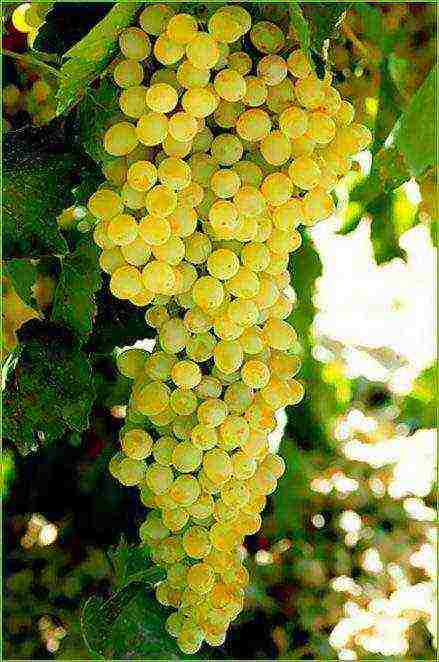
The property of seedlessness depends not only on the variety of grapes, but also on the conditions of its cultivation. Some species are seedless in one region, but degenerate with full seeds in another. So, pink grapes on the Crimean peninsula bear fruit in clusters with seeds inside the berries, and when grown in the Kiev region, seed embryos are not formed.
Of the seedless varieties, “black raisins” and “white raisins” are very popular among buyers, which are used for drying in order to obtain especially tasty raisins. Consider the most common seedless grape varieties - raisins.
"Arsenyevsky"
The representative belongs to the varieties of amateur selection with an average ripening period of 140 days. The grape flowers are functionally bisexual. The bunches differ in size, the berries look attractive and appetizing. The average weight of one bunch is 1300-1600 g.
Arsenyevsky is a large seedless grape variety. The berries differ in size and average weight up to 12 g each. "Kishmish Arsenyevsky" belongs to the second class of seedless plants.
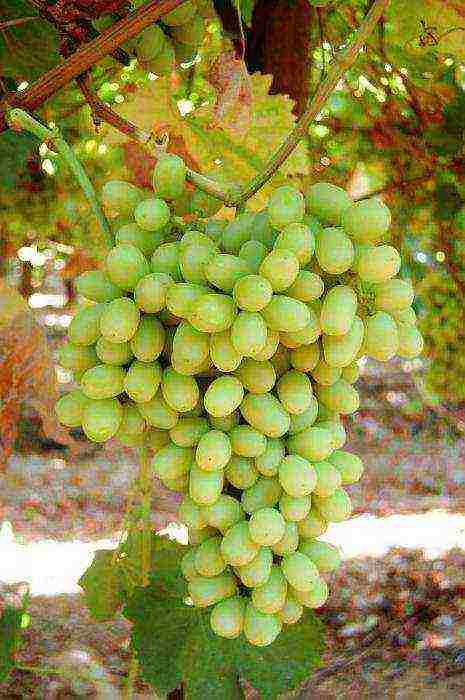
The grape variety is preserved for a long time. After ripening, the bunches can be left on the vine for a long time, without worrying that the berries will lose their taste. The presentation of the grapes does not deteriorate even after long transportation. Wasps practically do not damage the berries, so growing this species is profitable.
The lower permissible temperature level for Arsenyevsky grape bushes is -23 ° C.
"Kesha"
The ripening period of the variety is early, up to 115 days. This variety is seedless, table variety. The berries form clusters of cylindrical-conical shape, but smaller than those of the "Arsenyevsky", with an average weight of 300-500 g. The hearths are large, round, like most grape varieties of this group. Each of the berries accounts for 3-4 g, which, after ripening, turn amber with a brownish tint, occasionally yellow-green with a slight waxy bloom. The taste of kesha raisins is notable for its harmony, with moderate sweetness. Under the skin of medium thickness, there is a tasty, juicy pulp with a soft structure.
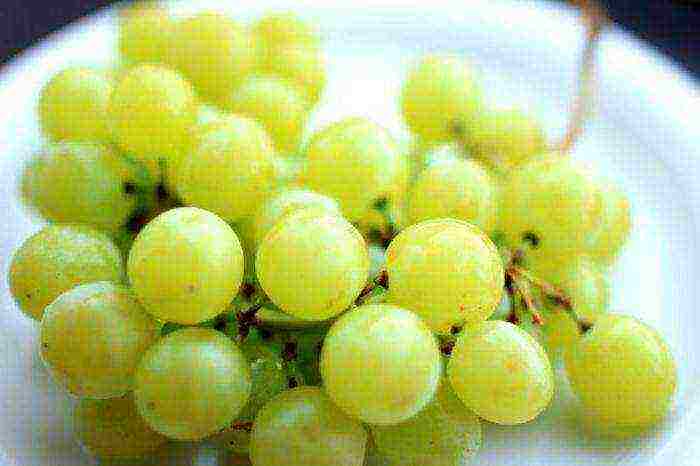
Sometimes, due to the strong density, individual berries fall to the ground, but this phenomenon is rarely observed. "Kesha" is notable for its fertility, and from one bush you can get up to 6.5 kg of selected grapes.
"White Flame"
The seedless white grape variety has a very early ripening period - 90-93 days. Berries weigh up to 5 g each, and the total weight of a bunch can reach 2-2.3 kg. After ripening, the grapes acquire a marbled color, filling with a blush.
"White Flame" is distinguished by a combination of rich and soft floral notes. Under the tender crispy skin there is a homogeneous pulp. Grapes are stored for a long time, but during long-term transportation, it is required to carefully pack the bunches in order to protect them from damage. The variety is frost-resistant. Even 20-degree cold does not matter to him.
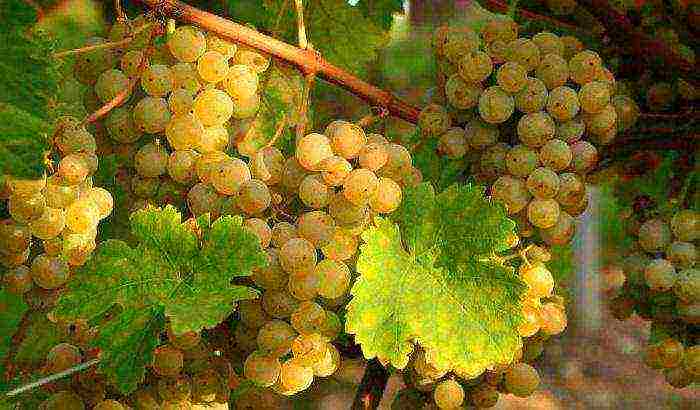
"Radiant"
The variety is high-yielding, with an average ripening period of 130-135 days. The berries are small, oval, slightly elongated, after ripening they reach a weight of up to 2 g, acquiring a pinkish color. The pulp is fleshy and juicy, with a slight nutmeg aftertaste.
Grapes "radiant" - a variety of small grapes without seeds, are classified as high-potential varieties of berries due to the weight of the bunches, the average weight of which reaches 650-800 g. and the formation of bunches weighing 2000 g.
By its taste, the variety is excellent for the production of raisins.
These types are ideal seedless grape varieties for central Russia. The berries are distinguished by good transportability and winter hardiness, therefore they can be grown in places with extreme temperatures. "Radiant" has a long shelf life, therefore it is often found on store shelves.
"Black"
The growing season is 127-133 days. The bushes are vigorous, but not frost-resistant and disease-resistant. Growing such a culture requires careful care of the grapes. This is a variety that is distinguished by its antiquity. They were one of the first to cultivate these grapes. Nevertheless, to this day, it has not lost its popularity.
Black berries with a bluish tint are medium-sized, sweet - contain up to 27% sugar, belong to the 3rd class of seedlessness and are distinguished by high taste. The yield per one hundred square meters is 100-230 kg and is characterized as high.
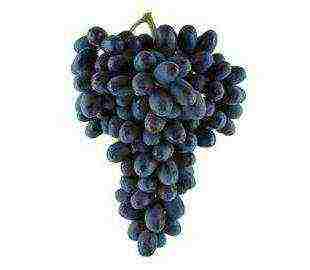
"Black Sultan"
The growing season is 113-117 days, so one can judge the early ripeness of the grapes. The bushes of this variety are vigorous, and the berries are medium in size. The peculiarity inherent in this species is the transitional class of seedlessness (2-3). The sugar content of the fruits is 17-25%, and the yield is up to 200 kg per hundred square meters.
"Red nutmeg"
The seedless red grape variety belongs to the group of early ripening - up to 115 days. The berries are large in size - up to 7 g, colored red, have a strong nutmeg taste. The average weight of one bunch is 650-850 g. "Red Muscat" is a high-yielding variety with a yield of 5 kg from one bush.
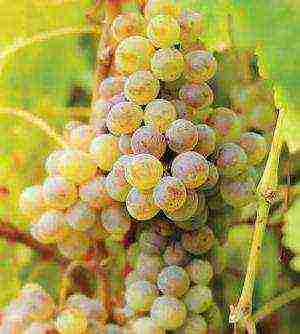
The grapes are highly resistant to frost and disease.
In addition to raisins, the korinka group of grapes is widespread, characterized by a multi-grade. Read on for a brief description of the two most popular grape varieties among consumers.
"Black Cinnamon"
This variety has been known since the times of ancient Greece. Today it is distributed in many countries of the world and is successfully cultivated in Europe. In central Russia, grapes ripen in 122-130 days, forming medium-sized clusters with small berries. Fragrant and juicy pulp is hidden under the thin skin. This variety is characterized by medium disease and frost resistance.
"Russian korinka"
The grapes are very early ripening, winter-hardy, not prone to soreness. During the growing season, forms strong, vigorous bushes with medium-sized clusters, densely covered with large berries. The pulp of the fruit is pleasant to the taste, without the aroma characteristic of grapes. Sugar content up to 21.5%. The yield is high - up to 156 kg per one hundred square meters.
You now know a lot of seedless grape names. Understand the peculiarities inherent in a particular variety, and you can try to distinguish which grapes are on the store shelf and what is better to choose for your goals.
.
Seedless grapes are those that have soft seeds or none at all. The varieties of this subspecies are popular varieties of planting material. There are many varieties of seedless grapes.
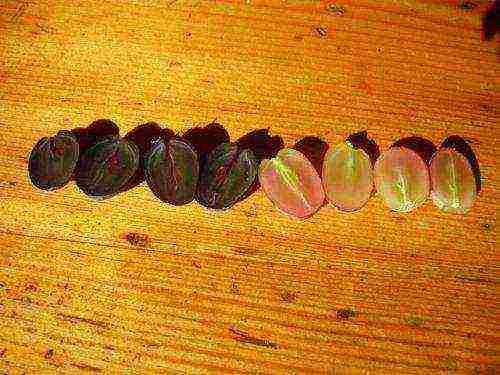
Kishmish - seedless grapes in berries
Properties of seedless grapes
The leading positions in popularity among seedless species are occupied by:
- white raisins;
- black raisins.
Black and white kishmish is intended to be consumed fresh or processed. Juices, wines and raisins are prepared on its basis.
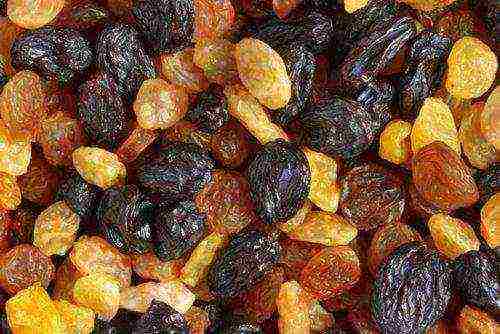
Raisins are dried seedless grapes
The most popular product of the seedless varieties is raisins.
The popularity of raisins is due to its benefits and pleasant taste. Thanks to the long shelf life, the raisins can be enjoyed for a long time. The by-product is used for eating or adding to various dishes.
The composition of raisins includes:
- Sodium, potassium and phosphorus.
- Magnesium, calcium, iron and boron.
- Vitamins and minerals.
- Fiber.
Thanks to the technology for the production of raisins, it is possible to preserve most of the vitamins and minerals that are kept fresh. The benefits of raisins and grapes are characterized by their positive effects on the immune system and the nervous system. Grapes in any form tones up and increases strength.
The main benefit of the product is provided to pregnant women and lactating mothers for whom the use of the product is not contraindicated.
It can be used as a remedy for joint diseases and to increase the level of iron in the blood.
Raisins from black or white grapes help flush out toxins from the body and stabilize the digestive system. According to research, dark grapes, both seedless and seeded grapes, are more beneficial.
The popularity of seedless grapes of black or white color is due to its ease of use and taste; raisins are distinguished by their sweetness and pleasant aftertaste.
The berries of such grapes are small in size, and are rarely located on a branch, but depending on the properties of different varieties, characteristics may vary.
Seedless species are not whimsical in care and need standard and plant-acceptable care. More often this culture is southern, but the result of selection work allows them to be grown in the north and in central Russia.
Seedless varieties
There are many varieties of seedless grapes, but among them there are popular varieties with advanced characteristics. These include Veles - this is a hybrid variety raisins, in the creation of which Sofia and Rusbol participated. The ripening rate is fast, the harvest is ready for harvest at the turn of July and August.
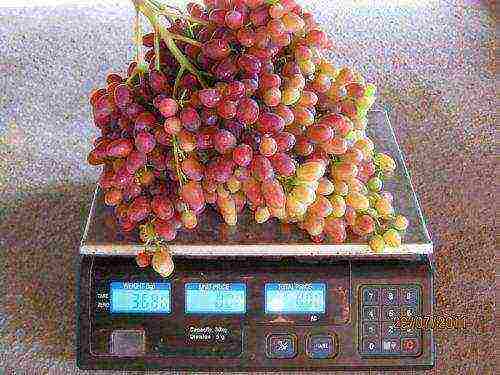
Bunch of grapes Veles
If you take care of the planting material correctly, then the weight of each bunch can be equal to three kilograms of weight. Veles' berries are large, which corresponds to the name of the variety. The berries grow in a pink elongated shape. Density in a cluster of medium density and notes of nutmeg. This variety has a high yield.
In most cases, seedless plant varieties have high yields.
Among the representatives of seedless varieties, the Century is popular - a variety with medium ripening and large bunches, the weight of which is two kilograms. The berry weighs nine grams. The bunches can hang on the vine, increasing the sugar content of the berries and improving their taste.

Kishmish Century has large white berries
Taste qualities of the Century are distinguished by a nutmeg note and a slight sourness in taste. This variety is frost-hardy, does not need to be covered when cold weather sets in. The century has always produced generous harvests.
Black finger is a late ripening raisin variety.
A distinctive feature of grapes is resistance to cold weather. The variety grows large clusters with rare berries. the name of the grapes is due to the shape of the berry. Seedless grapes of a particular variety are susceptible to diseases, therefore, they need careful care.
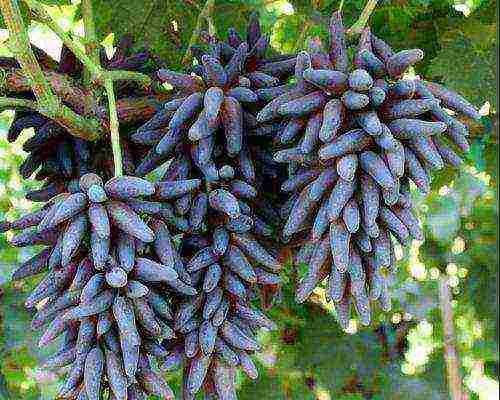
Black finger kishmish looks amazing
The early ripening radiant seedless grape has large pink berries. Taste qualities are pleasant, have a nutmeg note. The variety is not resistant to diseases and does not tolerate cold. For proper cultivation, it should be covered for the winter and in the process of growth, treatments against diseases should be carried out. The advantages of the variety are that it can be transported and has good keeping quality.
The cultivation of seedless grape varieties is associated with the taste of the plant and its beneficial properties. The benefits of grapes of any varieties have been known for a long time, and the popularity of growing this plant is connected with this.

Radiant kishmish has a nutmeg aroma
Many years ago, growing grapes was the prerogative of wealthy and influential families, but today everyone can afford to grow a plant on their site. The main requirement for planting it is time to take care of the material. Black and white grapes without seeds and standard varieties need constant monitoring and care. otherwise, it will become neglected and may become ill.
Subscribe Be aware of new products on our site
Grapes are the most delicate juicy berries, sweet, aromatic, with a rich taste - a storehouse of useful substances and vitamins, regardless of whether they are consumed fresh or dried. These small berries, collected in delicious bunches, for thousands of years they have been serving as raw materials for wines, champagnes and cognacs of various varieties - sophisticated aged drinks and young sparkling ones.In this review, we will consider the most popular seedless grape varieties.
Benefits of raisins grapes
Perhaps grapes are one of the most common crops on earth. There is no country where they would not try to grow it on an industrial scale or on their own garden plot. Maybe that's why, despite the fact that there are more than 600 varieties of wine in nature, breeders are still developing new cultivated and hybrid species.
 Seedless grapes raisins
Seedless grapes raisins
Seedless grapes are especially popular. This is not surprising - it is much more pleasant to bite through a juicy berry when small hard bones do not bother you. In addition, it is these berries that are most suitable for drying and obtaining raisins.
It is seedless varieties that are the most productive and frost-resistant at early ripening periods.
The oldest known seedless grapes are raisins and cinnamon. It is customary to add the word kishmish to modern ones to emphasize that there is no bone in the fruit. Korinka is a small black very sweet grape of Corinthian origin, and even now in Greece (the city of Piraeus) there is a research institute for raisins.
It is the seedless species that is used to pollinate other varieties in order to obtain new hybrids. Berries of any seedless species have an ideal combination of natural acids and sugars, have a rich sweet taste, a unique aroma and a thin skin. They are suitable for fresh consumption, dried in the form of raisins, making the most exquisite wines and cognacs.
How does reproduction take place
Indeed, how does this grape multiply if there are no seeds in it? Almost all known seedless species are bred by breeders thanks to the crossing of natural species of raisins - Black Monucca and Thompson... Each of them has its own individual characteristics: the shape of the berries, the color, size and size of the seeds. Why is there no bone in the raisins? The fact is that the bones are not completely absent, they are simply underdeveloped. In varieties of quiche mish, they can be very small or barely distinguishable, soft, and also differ in quantity.
 For propagation of seedless grapes, vegetative methods are used, including the use of cuttings and cuttings
For propagation of seedless grapes, vegetative methods are used, including the use of cuttings and cuttings
The lack of seeds in grapes is a genetic trait, specially laid down by breeders when developing new varieties.
Grapes of any variety - seed and seedless - are propagated vegetatively, i.e. with the help of cuttings and shoots, and the seeds are needed only for breeding completely new varieties.
Breeders have even learned to grow new varieties of seedless grapes from underdeveloped seeds. And here reproduction with preservation of all genetic characteristics and qualities varieties are possible only with a vegetative method.
Kishmish is fertilized by pollination, so there are traces of seeds in the berries, although their development stops at an early stage. Cinnamon ovary occurs WITHOUT POLLINATION, and they do not have a seed at all.
Most common seedless varieties
These varieties differ in the size and degree of seed maturity, frost resistance, and ripening times. Let's consider the most popular of them and give their names.
Kishmish
There are a great many varieties of raisins, but gardeners prefer mainly traditional, time-tested varieties.
Radiant
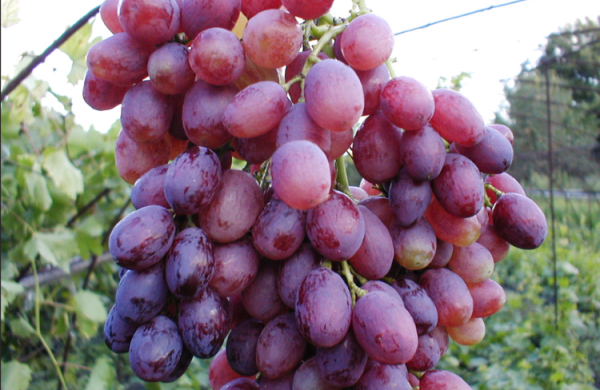 Kishmish Radiant
Kishmish Radiant
Mid-ripening (ripens in 130-135 days), the vine is developed, medium or vigorous. Berries are small - 2g, elongated, pink in color, the pulp is juicy, fleshy, with a rich nutmeg aroma, universal use. Forms a bunch up to 2 kg in weight. It is perfectly stored, transported, tolerates low temperatures well.
Zaporizhzhya
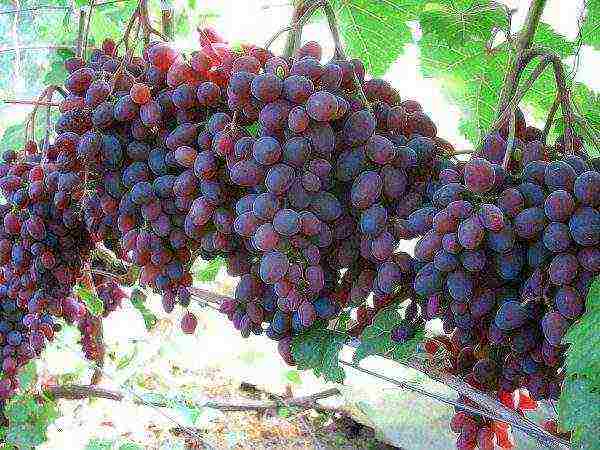 Kishmish Zaporozhye
Kishmish Zaporozhye
Early ripe table grapes, reddish-purple berries, oval, rich taste, very fleshy juicy berries. The vine has increased resistance to frost and disease.
Black
 Kishmish Black
Kishmish Black
One of the ancient varieties, with all the usual qualities, black grapes have special flavoring and beneficial properties: a dark color indicates a huge amount of antioxidants, the benefits of which for the body are inestimable. Anthocyanins are able to slow down the growth of cancer cells, inflammatory processes, facilitate the course of diabetes mellitus (recommended for diabetics, as it has a low glycemic level), and prevent the development of fatty layers. High-yielding and frost-resistant, but requires careful maintenance.
Kesha
 Kesha grapes
Kesha grapes
A culture of early ripening, up to 115 days, berries weighing 3-4g, rounded, juicy, tender pulp, medium density peel. Ripe berries from amber with a brownish tint to greenish-yellow. The brushes are dense, small - 300-400 g, but the yield of the bushes is high - up to 6.5 kg.
Kenadis
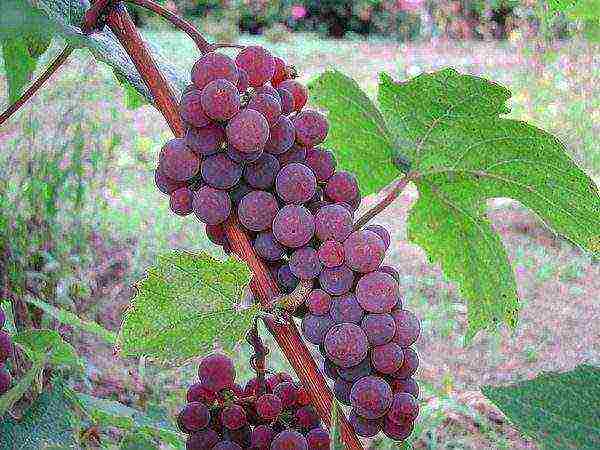 Kenadis grape
Kenadis grape
High yielding, the most frost-resistant of seedless (withstands t -30o), table grapes, perfectly stored for up to 4 months, most often used for juicing because of their light isabelle taste. The berries are pink, with a transition to red.
Himrod
 Himrod grape
Himrod grape
Early to medium ripening, small, pale yellow berries. Its specific taste and aroma allows it to be used for making white wines. Resistant to frost and fungal diseases.
Jupiter, Neptune, Mars
Berries differ little from each other, color - violet-red, large fleshy fruits, fragrant. Plants are fertile and frost-resistant, not affected by fungal diseases and gray rot. Jupiter is used to make aromatic, sweet red wines.
Unpretentiousness, disease resistance, cold tolerance, high yield, impeccable taste and, most importantly, lack of seeds - an optimal set of the best qualities of grapes. That is why seedless varieties deserve the attention of gardeners and consumers.


